In the Shadow of Bam Bam
Can teen boxing prodigy Dylan Cayuga make good on the promise of fallen fighter Richard Duran?
by Scott Thomas Anderson
Originally published on
December 8, 2016 in
Sacramento News &
Review
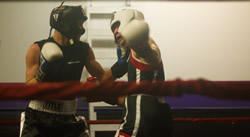 Dylan Cayuga
lands an upper-cut on
Dylan Cayuga
lands an upper-cut on
Ricardo Mancillain in South
Sacramento.
Photo by Karlos Rene Ayala
Sacramento News & Review

Ricardo Mancillain in South Sacramento.
Photo by Karlos Rene Ayala
Dylan Cayuga’s knuckles crack the focus mitts, batting his trainer’s padded palms like a rifle volley that terrorizes the air. He jabs one, pivots and throws a cross at the other. It’s the sound of shock batons—a whip and a snapped window.
The reverberations echo in Caballero NorCal Boxing Club on Stockton Boulevard. The winter sun glints through the gym’s roll-up doors as an audience enjoys the final matches of an amateur boxing event. Cayuga and his coach Shawn Porghavami finish with the mitts. The crowd knows what comes next: Cayuga, who just turned 17, is about to fight 27-year-old Ricardo Mancilla. Each combatant hits the scale at 134 pounds, though Mancilla’s poundage is built on him in visible biceps, triceps and deltoids. His brawny frame stands in contrast to that of the lean high schooler.
Cayuga glances at his opponent before climbing through the ropes. “He’s just human, same as me,” he says to himself. That’s the mindset behind why Cayuga has arrived today with a record of nine wins and one loss—the one defeat a controversial judges’ decision in San Francisco the week before. Now, Cayuga is determined to get back into the winning column by pushing his record to 10-and-1. The teenager just has to go through Mancilla to do it, just has to survive the man who’s now stretching and flexing a tatted, rock-solid torso powering the incoming punches when the action starts.
The longtime boxing aficionados watching Cayuga know there’s more than his own professional aspirations riding on those slim shoulders: His fighting style, his relentless workouts, the philosophy behind his mental approach, are all tied to the late guru of the gloves Richard “Bam Bam” Duran. Dead now five years, Duran remains the Greek tragedy of Sacramento boxing, an Olympian hopeful and two-time world title contender whose future was altered by a deadly bar fight in 2000.
Duran’s determination to find meaning in one senseless blur of violence was cut short when he died of a sudden stroke at the age of 44. Cayuga may be chasing his own passion and future in the ring, but for those who remember what Duran was, and might have been, the heights this prodigy soars to could validate Duran’s final quest for redemption. It’s an unspoken question half-haunting Lord’s Gym: Can Cayuga’s fists punch up a new ending for Bam Bam with a shot at the Golden Gloves? As far as the teen is concerned, the answer starts tonight.
Round 1: The quiet kid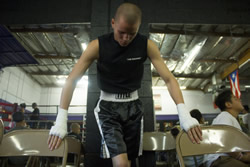
Cabellero's November 12 fight schedule is well underway as Cayuga checks his gloves and Mancilla idles with a cold calmness across the ring. When the referee calls each man to the center, Cayuga drills a deadened stare into the eyes looking back at him. He does not blink.
It starts with a jab—light, fast and snapping. Cayuga’s quickness is evident. He goes directly at Mancilla and, after landing the first punch, closes the distance with a double-left knuckle rap against the other’s cheek. And he keeps attacking. He fires a fast right hook into Mancilla’s ribs. The stronger boxer tries to counter but the teenager is already out of reach.
Now Cayuga lands a right cross. Mancilla retaliates with an uppercut. Cayuga’s jab stays on target and the two are suddenly tangled. When the referee breaks them, Mancilla is hit with another missile near his chin.
Behind the ropes, Porghavami watches his fighter remain on offense. He knows fans who have never seen Cayuga before probably won’t be able to peg his personality.
“Dylan is actually a quiet kid, even a little soft-spoken,” Porghavami says. “He’s a good kid, and I think he really feels at home with the guys in our gym. Everyone there knows that he’s got heart for days.”
Cayuga may not be talkative, but he has no problem describing what he loves about boxing. For the junior at Roseville’s Adelante Continuation School, strapping on the gloves is a way of constant self-challenge. He likes pushing his body. He gets energized by the pelting pops of mitt work. He especially enjoys touring Sacramento’s boxing clubs to spar with new people, dealing in real time with whatever unexpected arsenal or skill set he’s practicing against.
Cayuga is addicted to mastering his nerves before a fight, as well as the internal surge from having his arm raised up as the winner. He’s not shy anymore about announcing his plans.
“I’m trying to get as far as I can in this sport,” he says.
And to do that, at this moment, Cayuga has to keep the pressure on. Mancilla wraps him up in another hug. The third time the referee separates them, Cayuga punishes Mancilla with a swift, four-punch flurry to his sternum capped by a left hook. It’s a boxing combination reminiscent of one of Duran’s best televised moments in the ring, a flash that came during his first shot at the junior-featherweight title in 1993. After competing in the Olympic trials and winning a staggering 111 amateur fights, Duran went pro and, by the age of 26, was granted his initial championship match. Fighting out of Midtown Sacramento’s Washington Neighborhood Center, he was an undefeated professional that night with a record of 26-0. He was also ranked the No. 2 fighter in the world in his weight class. On that evening in April 1993, Duran walked into Sacramento’s Arco Arena to battle for glory against the only man he’d ever lost an amateur bout to, Kennedy McKinney, of Memphis, Tenn.
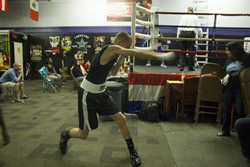
are trademarks of Dylan Cayuga and
the late Richard Duran.
Back then, the Capital City’s boxing fans were electrified as Duran stalked McKinney around the ring, flustering him with lightning jabs and roller skate footwork, waging an up-close war while still keeping beyond the champ’s 4-inch reach advantage. Halfway through the first round, Duran exploded on McKinney, battering him with a concrete left to the face, hitting him with a hook down low and finishing the onslaught with a wide, right punch to the champ’s ribs. The Sacramento fans erupted in applause.
“Richard had a style, and an unbelievable run as an amateur, and then there he was, fighting for the title,” recalls former Sacramento boxer Shawn Holmes, one of Duran’s teammates under the hard-charging coach Don Conley. “It was such an exciting time for everyone at our gym.”
Those memories are still alive in the church basement of Lord’s Gym in Roseville where Cayuga trains every night. While the new fighter is sparring, sweating and hitting the mitts, he can see a wall full of photographs: Duran surrounded by trophies as a teenager; Duran in his Olympic trial warmups in 1984; Duran posing next to boxing legend Sugar Ray Leonard.
It’s motivation. And Cayuga shows that motivation now by ending the first round against Mancilla strong, completely ducking a tight roundhouse as the bell rings.
Round 2: Roll with the punchesThe spectators at Caballero's want to see what Cayuga does next. The aroma of carnitas sizzling on a propane grill drifts in through the roll-up door as a neighborhood family serves tacos and meat-slathered nachos to the audience. Children play outside in the business park's corridors while their parents chat around the ring. Boxers who have already finished their bouts lazily unwrap their hands over duffel bags.
Cayuga waits for the bell. Four gym mates shout encouragement from the front. No members of Cayuga’s family are here tonight, but the teenagers who constantly share with him the risk and punishment of the ring make sure he feels the presence of a second family. That’s almost always what his cheering section looks like. It’s peer support a 17-year-old can feel. He knows he’s not alone. He may just be a kid who works at a car wash and loves watching YouTube videos of Muhammad Ali, Andre Ward and Roy Jones Jr., but he says he’s always experienced support from his gym while learning “the sweet science” of the knuckles.
“Coach checks in with me and makes sure everything is going good, you know, home life and stuff, and usually it is,” Cayuga says.
Cayuga hears the bell and makes a beeline for Mancilla. The more powerful of the two looks for an opening, but Cayuga is already stopping him with steady punches. Mancilla starts diving in at Cayuga’s waist to pin his arms down, while simultaneously throwing punches at the side of the younger boxer’s ribs or skull.
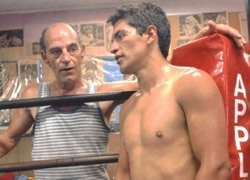
next to legendary Sacramento boxing coach Don Conely
The awkward back-and-forth continues for the next minute, Cayuga landing rapid face-shots and Mancilla grabbing him around the center to hammer away at the inside. But Porghavami has told his fighter to anticipate this. And so, late in the second, after the ref breaks them apart, Cayuga clips Mancilla’s eye with a jab. The teen then turns with flawless side-to-side footwork and bombs his adversary with a left hook to the midsection before jabbing up high and rocking Mancilla’s head with perfect left-right assault.
Mancilla attempts to counter only for Cayuga to duck his hook with the artistry judges love to see. This defensive display is what Cayuga has been training for in that obscure church basement, that ring illuminated by caged garage lights near concentration bags anchored with buckets of cement and heavy bags dangling on chains from exposed iron beams. The rough-edged fighting zone has taught Cayuga to dip, tuck and roll his shoulders when the punches are coming.
While equipment at Lord’s Gym isn’t new or state of the art, neither was the equipment at Conley’s Washington Neighborhood Center, which launched champions like Loreto Garza and figures like Duran.
“You don’t need a bunch of shiny gear or fancy stuff,” Porghavami tells his students. “You just need to be willing to work and have that hunger inside.”
Cayuga looks hungry enough now in the ring, growing more aggressive as he lands a flying right cross to Mancilla’s head. A cocktail of cheers and moans reverberates through the gym. “Niiiice!” one fan yells from the front. “Beautiful shot, blue!” another calls out.
Cayuga and Porghavami are adhering to a basic strategy with boxing judges— control the middle of the fight. In an amateur bout, that means make a show like this in the second round.
For Richard Duran, in Arco Arena on that night back in April of 1993, it meant holding the line in the sixth round. But early in the match McKinney made a cut above Duran’s left eye by way of a walloping jab. Halfway through the sixth, Duran’s eye was spilling blood and creating a challenge for the team in his corner. Duran pressed on, landing classic combinations on the champ, continuing to hurt him inside and out. Yet the cut kept breaking open. Duran fought through blood dripping onto his cornea. In the final round the commentators had Duran and McKinney nearly even on the score cards, but Duran kept getting hit with the champ’s long, leaning jab. He took punch after punch around the cut above his eye. Duran slowed, and then slowed more, until the fight ended with his head lowered and McKinney still holding a belt.
One year later, the International Boxing Federation gave Duran his second shot at the super-bantamweight title when they cleared him to fight champion Tracy Harris Patterson. The match took place in Reno, Nevada, and Duran again found himself on the losing end of a decision.
Duran’s loss to Patterson started a running line with boxing commentators that, at age 28, he was physically spent from the years of dominating as an amateur. The rap was that 112 amateur fights and 30 professional battles had cost too much.
Duran retired in 1994, but he hadn’t seen anything like the bottom yet. Though he sometimes volunteered at the Washington Neighborhood Center, rumors of out-of-control drinking began to follow him. It was also whispered he was starting to get into fistfights outside of the ring. Duran had already felt the brunt of a well-publicized DUI arrest before his title match with McKinney, and several years and a failed career later, some boxers and trainers in the Capital City were worried.
On the other hand, he was still the Bam Bam everybody loved: still the joker who lived for surprising people with pranks; still the gym rat who played air guitar and blasted hard rock while other boxers were sparring; still the engaging life of the party who seemed to have a best friend in every major city from Colorado to the West Coast. At age 36, Duran started talking about getting serious with coaching. His new dream was to train a champion. People were rooting for his success. Duran’s supportive attitude and friendly nature made it hard not to. So, it came as a shock to many when Bam Bam was arrested for murder in the summer of 2000.
According to statements made at the time by the Sacramento Police Department, Duran had been hanging out that evening at Jose’s Hideaway on Northgate Boulevard. During the early morning hours, a brawl broke out in the front parking lot between several men. Police said 36-year-old Artemio Cabrera attempted to separate those involved and ended up in a showdown with Duran. Some of Duran’s friends, on the other hand, claim Cabrera “jumped” the boxer. Either way, up against a professional fighter’s weaponized knuckles, Cabrera went down. He never got back up.
A few days later, hearing that homicide detectives were looking for him, Duran turned himself in. The news quickly made headlines in Sacramento. Duran’s main sparring partner at the Washington Neighborhood Center, former pro Miguel Pantoja, remembers how talk of the bloodshed was circulating through the boxing world.
“I think more than anything, most of the people who spoke about it felt sorry for [Duran],” Pantoja recalls. “We knew he was going to do time, and be away from his family, and this would be going down on his record as a felony.”
Duran eventually pleaded guilty to involuntary manslaughter and was sentenced to a year in prison.
Duran’s sister, Tracy Madrid, says the brief time he spent behind bars marked a turning point.
“I would say he was different after he left prison,” Madrid observes. “I think he wanted more for his family, more for his little girls, and I know he wanted to prove that people can make a positive change in their lives.”
Duran’s turnaround created a program that later opened a world of possibilities for Cayuga.
Round 3: The contender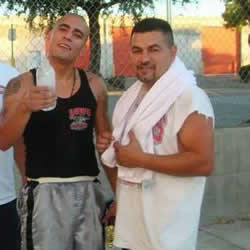 The last fighter Richard Duran trained
The last fighter Richard Duran trainedwas Mario Monarrez.
The contest between Cayuga and Mancilla is minutes away from being decided. They wait in their corners for the final round. Mancilla sits on his bench, taking deep breaths. Cayuga remains standing, rocking on his heels. Some in the audience think Mancilla's only hope to win is leveraging his upper body strength for a knockout. After all, this is boxing: It could be done with a single, well-timed uppercut to the teenager's chin.
Mancilla pressures Cayuga into the ropes, searching for an opening. Yet before the stronger man can launch a blow, Cayuga slips a line-drive punch through his defense to connect with his face. Mancilla jumps in, trying to wrap Cayuga up again: He’s stopped by a machine gun combo of punches firing on his chest. Despite these direct hits, Mancilla makes his move, punching the side of Cayuga’s head with a bruising left hook.
But it’s not a knockout.
Mancilla returns to trying to clench. Cayuga is circling and quickly slams his opponent’s face with another left-right cadence. Cayuga appears to be fighting with as much energy as he had in the first round. The moment crystallizes why people around Northern California’s boxing scene have noticed that the 17-year-old’s steady, controlled aggression—it comes from lungs that never seem to run out of air.
“The wind in his chest is unbelievable,” Porghavami observes. “Dylan started boxing in amazing shape, because he’d trained for marathons in high school. But the system we have in our gym, and the huge emphasis we put on cardio conditioning, allowed him to reach another level. He has the stamina now to always be on the attack, round after round. And a lot of the training system comes directly from Duran.”
Porghavami was 18 when he first met Duran. Roseville’s Abundant Life Church had asked Duran if he’d start a boxing program as a form of youth outreach. Duran was struggling financially, but the ability to make a positive impact was a chance he wouldn’t pass up. The boxing club at Lord’s Gym soon became his driving passion. Duran didn’t own a car and rode his bike 16 miles in both directions every day, pedaling from his home in Del Paso Heights to the Lord’s Gym in downtown Roseville.
Bam Bam’s teammate from the Conley days, Holmes, agreed to be an assistant coach. Holmes says Duran was intent on using his talents and life experience in a way that would give troubled young men and women a positive outlet. Porghavami felt the vibe right away.
“I did boxing as a way to stay out of trouble and get away from some bad habits,” Porghavami recalls. “The take on boxing at the Lord’s Gym got me out of a rough patch, and I fell in love with it.”
The future coach also learned some humility from Duran. “He was pretty quiet, and never talked about his professional career,” Porghavami says. “Most people there didn’t know he’d been a contender.”
Unless they sparred him. James Dorris, currently the International Boxing Association cruiserweight and super-cruiserweight champion for Badge Vs. Badge police boxing as well as heavyweight champion for Battle of the Badges police boxing, started his career training with Duran at Lord’s Gym.
“Even though guys were younger than him, they’d be sparring him and couldn’t hit him at all,” Dorris remembers. “I’d be sparring him and I’d throw some five or six-punch combination, and then I’d realize, ’I don’t think I touched him even once.’”
One of Duran’s main students at Lord’s Gym, boxer Mario Monarrez, began winning amateur fights around California and Nevada. Duran set his sights on taking Monarrez to the pros. But in the spring of 2011, Holmes and Monarrez both noticed Duran wasn’t looking well. He mentioned serious issues with his blood pressure.
“The medication they gave him made him really drowsy, and sometimes if he took it, he’d end up missing a couple days at the gym,” Monarrez says. “The gym was his life. He wanted to be there every day, no matter what; and so he didn’t like taking the medicine.”
On April 26, 2011, Duran died of a massive stroke. Local boxers and coaches were stunned. Sacramento’s former boxing champion Tony “The Tiger” Lopez told reporters Duran was “a warrior in and out of the ring” and a man whose real legacy was helping “keep kids off the streets.”
The loss hit Monarrez especially hard. “Bam Bam was more than a coach,” he says, “it was like losing a second father.”
Afraid the impact Duran was having with young people would die with him, Holmes volunteered to keep the Bam Bam Boxing program alive. Two years ago, Holmes helped one of his top students—Porghavami—take over as the main coach.
“We didn’t want to see Richard’s style and method and mission get changed by someone,” Porghavami says.
Cayuga walked into the gym soon after. Holmes and Porghavami saw the kid’s raw talent immediately. The more they trained Cayuga, the more they gauged what they call a natural fearlessness and a rare ability to follow a game plan during an actual fight. They also spotted an important personal quality in Cayuga.
“On top of his amazing conditioning, his technique and his ability to soak up boxing lessons like a sponge, Dylan is also just really nice,” Holmes says. “No matter how well he’s doing, he’s someone who can check his ego at the door, which is important to what we’ve been trying to teach all of the young people who come through.”
But ego and confidence are different forces, and now, in the final minute of the third round, Cayuga needs the latter. He slips out of one of Mancilla’s hugs to land a jab before stepping left and cross-drilling his opponent’s face with a right hand. It’s just what Porghavami wants to see. He wants Cayuga to hear their plan inside his head, to execute the in-and-out footwork laced with punches they discussed: Left, step, right. Left, step, right. Left, step, right.
Mancilla tries to grab Cayuga one more time, but the teen shimmies sideways and drives a right cross straight into his kisser. “Ah-ha-oooh!” a spectator hollers out. Dull tapping on wood indicates the final seconds of the round. Cayuga makes sure the judges see he lands the parting shot.
When Cayuga yanks his headgear off, it’s the first moment he’s smiling. For an instant he no longer looks like a young Marine recruit heading into a war zone—just for a second, he looks like a regular teen on top of the world. The judges make it official: Cayuga now has 10 wins to his one loss.
If he stays on this track, fighting for Golden Gloves or getting invited to Olympic trials could be within reach. For Cayuga, this feeling swelling under the ribs could not come any other way.
“Boxing is what I love to do: It’s the main thing I think about now,” he says. “People want me to focus on school and everything, but boxing is just totally different. It’s what I want to spend all my time on.”
And it’s this endless thirst for the thrill that links Cayuga to the spirit of the man who started his club’s program—a nexus where the shadow of Bam Bam recedes to a point of illumination. Maybe people like Duran’s sister are the only outsiders who understand what makes a contender tick.
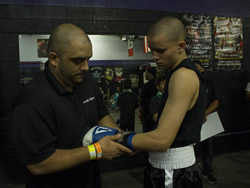
keeps a close eye on Cayuga. Photo by
Karlos Rene Ayala
“Richard once told me that he couldn’t breath without boxing,” Tracy Madrid says, fighting back tears.
Whether or not Cayuga becomes the kind of professional boxer Duran dreamed of training, he and the late fighter already share a knowledge of that rare high that comes dancing on the line of grace and chaos. The rush is so strong that, right now, Cayuga isn’t even envisioning any other career outside of the ring. He wants more of that high. He knows it can only be found in boxing. And he’s aware Duran found it first.
“I’ve heard a lot about what Duran did, not just as a pro, but as an amateur, which is where I am right now,” Cayuga says. “I’m trying to live up to what he did, and be the best fighter I can be.”
